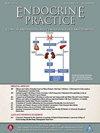Pituitary Stalk Lesions: Causes and Diagnostic Challenges
IF 4.6
3区 医学
Q2 ENDOCRINOLOGY & METABOLISM
引用次数: 0
Abstract
The pituitary stalk (PS) is a funnel-shaped structure that connects the hypothalamus to the pituitary gland. It contains some anterior pituitary cells, the hypophyseal vessels, and the axons of neurons whose bodies are located in the hypothalamus and terminate in the posterior pituitary gland, where they store and release arginine vasopressin and oxytocin. The PS is best visualized by magnetic resonance imaging. PS thickening (PST) is often associated with arginine vasopressin deficiency, but it can also present with anterior pituitary hormones deficits or normal pituitary function. PST can be an isolated finding, or be expression of a multisystem infectious, inflammatory, or neoplastic process. Accordingly, these cases are best managed with the input of pituitary specialists from different disciplines. Although PS biopsy can provide a pathologic diagnosis, this is an invasive procedure that requires an experienced neurosurgeon and carries significant risks. This review discusses the causes and symptoms of PST, and addresses the demographic, history, physical examination, biochemical and radiological features that can help the endocrinologist in identifying the most likely cause of PST in any given patient, and to decide when biopsy is needed.
垂体柄病变:原因和诊断挑战。
垂体柄(PS)是连接下丘脑和脑垂体的漏斗状结构。它包含一些垂体前细胞,垂体血管和神经元的轴突,这些神经元的体位于下丘脑并终止于垂体后腺,在那里储存和释放精氨酸加压素(AVP)和催产素。核磁共振成像(MRI)可以很好地观察到PS。PS增厚(PST)常与AVP缺乏相关,但也可表现为垂体前叶激素不足或垂体功能正常。PST可以是孤立的发现,也可以是多系统感染、炎症或肿瘤过程的表达。因此,这些病例最好与来自不同学科的垂体专家一起处理。虽然PS活检可以提供病理诊断,但这是一种侵入性手术,需要经验丰富的神经外科医生,而且风险很大。这篇综述讨论了PST的病因和症状,并讨论了人口统计学、病史、体格检查、生化和放射学特征,这些特征可以帮助内分泌学家在任何给定患者中确定最可能的PST病因,并决定何时需要活检。
本文章由计算机程序翻译,如有差异,请以英文原文为准。
求助全文
约1分钟内获得全文
求助全文
来源期刊

Endocrine Practice
ENDOCRINOLOGY & METABOLISM-
CiteScore
7.60
自引率
2.40%
发文量
546
审稿时长
41 days
期刊介绍:
Endocrine Practice (ISSN: 1530-891X), a peer-reviewed journal published twelve times a year, is the official journal of the American Association of Clinical Endocrinologists (AACE). The primary mission of Endocrine Practice is to enhance the health care of patients with endocrine diseases through continuing education of practicing endocrinologists.
 求助内容:
求助内容: 应助结果提醒方式:
应助结果提醒方式:


